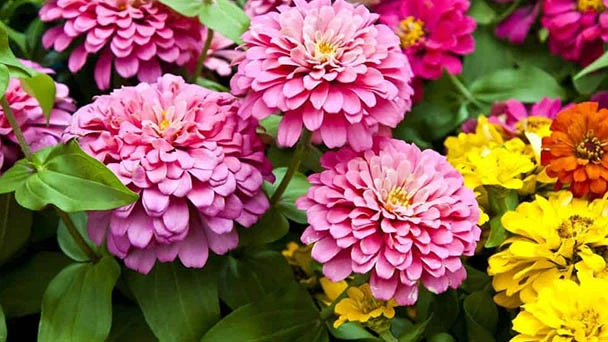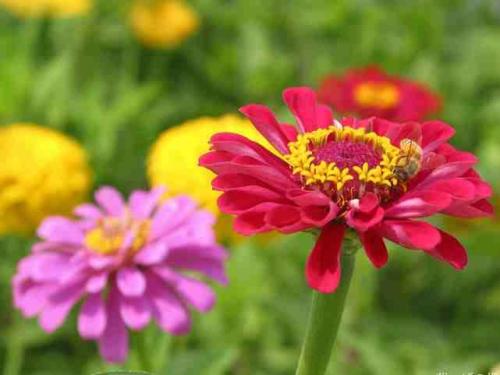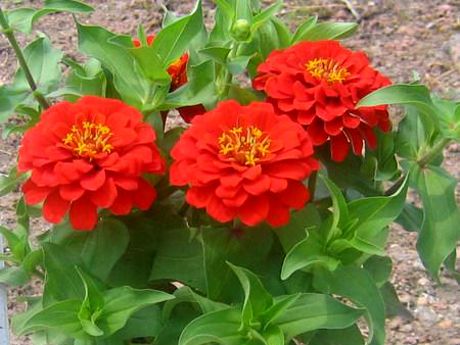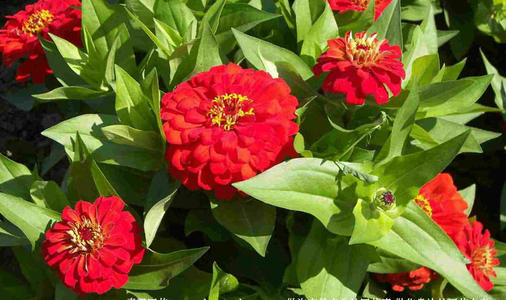How to Care for Common Zinnia (Zinnia Elegans)
Written by Maggie
Nov 15 2021

Common Zinnia flowers (Zinnia Elegans) are bright, beautiful and have great effect in medicinal value. So how to care for Common Zinnia? Today we will talk about Common Zinnia care for growing excessively or leaves having brown and white spots.

Common Zinnia Quick Info
| Botanical/Scientific Name | Zinnia Elegans |
| Common Name | Common Zinnia |
| When to Grow/Bloom/Harvest | Grow in spring/Bloom in late spring until the first frost in fall |
| Uses | Cutting flowers or as food for butterflies. |
| Origin | Mexico and Central America |
| Light Care | Full sun |
| Soil Care | Well-drained |
| Temperature Care | Range of 74–84°F (23–28°C) |
| Humidity Care | Moisture |
| Watering | Supplemental watering |
| Pruning Care | Remove any wilting flowers |
| Fertilizer Care | Balanced fertilizer |
| Propagation | Stem cuttings |
| Toxic | Aren't toxic |
| Flower Color | Pink, red, purple, orange, yellow, lavender, white and even green |
Common zinnia care for growing excessively
1. Zinnia Watering Care
Common Zinnia's excessive growth may be caused by too much watering. If common zinnia is watered too much, it will lead to root water, which will affect the respiration of Common Zinnia's root system. Finally, it will cause Common Zinnia's growth, and even water rot the roots, so that the branches and leaves gradually turn yellow, so that Common Zinnia wither and die.
Solution: When we care for zinnia, if it is found that Common Zinnia's growth is caused by too much watering, it needs to be moved to the sun immediately, or it can be directly changed into a piece of soil. Although Common Zinnia needs water very much, it needs to control the amount of water every time it is watered. It is better to ensure that the soil is semi-dry, so that Common Zinnia can grow normally.
2. Zinnia Fertilizing Care
When growing Common Zinnia, flower friends found that Common Zinnia grows excessively. I do not know the specific reason, but it is probably caused by excessive fertilization. If too much fertilization is applied, the roots of Common Zinnia will absorb a lot of nutrients.
Solution: When caring for zinnia, if you apply too much fertilizer, first, move it out into the sun and water the roots with fresh water so that the fertilizer comes out of the bottom of the pot. General Common Zinnia is fertilized every other month in the spring and fall if raised using normal fertilization methods. Summer is the flowering season, you need to apply nitrogen fertilizer twice a month.
3. Zinnia Sunlight Care
Common Zinnia needs to grow better under sufficient sunlight, where it can photosynthesize, making it grow more lush and more ornamental. When we care for Common Zinnia, if Common Zinnia grows in a cool place for a long time, it is easy to cause poor growth and finally grow in fuzziness, which affects the overall appearance of Common Zinnia.
Solution: if Common zinnia is caused by long-term growth in a cool place, we need to place it in a sunny place, immediately accept the sunshine, and need to pay attention to Common zinnia can't in the strong sunshine illuminate, otherwise it is easy to cause Common zinnia die. When we care for Zinnia in the summer, we should look for a place where astigmatism can make Common zinnia better growth.
4. Zinnia Pruning Care
Moderate growth has to do for Common zinnia to give it a cut once a year, after its flowering. When we care for Zinnia, old branch, disease branch cut off entirely, which can reduce the Common zinnia consumption of nutrients in the soil, make it grow better, open out more bright-coloured flower, increase Common zinnia ornamental value, and also prevent Common zinnia moderate growth.

Common Zinnia care for leaves having brown and white spots
Common zinnia have brown spots and white pink patches on its leaves, which are suffering from brown spots and powdery mildew.
(1) Brown spot: the earliest appearance on the leaf is dark brown small spots, and then appear irregular large spots, reddish brown, and finally developed into the whole leaf brown dry, petal shriveling dry.
Prevention and control method: When we grow and care for Zinnia, place it in good drainage area, planting density is appropriate, do not continuous planting, sowing seeds should be pre-disinfected (50 {bf} carbendazim wettable powder 1000 times liquid immersion for 10 minutes); Seed are chosen from healthy, disease-free plants; Concentrated destruction of diseased leaves and stems are sprayed with 50 {bf} diazepine or diazepine 500 times solution.
(2) Powdery mildew: the beginning of the surface of the leaf sporadic white powder, then the leaf is covered with gray powder, and finally withered and withered.
Prevention and control methods: When we grow and care for Common Zinnia, place it in the ventilated, good drainage place, planting density is appropriate; Pulling out the diseased plants and destroying them in time; Spray with 15 {BF} powder rust rather wet powder 1000 times liquid or 70 {BF} methyl tobutin wettable powder 1000 times liquid.

Latest Updated
- Benefits of Bugleweed - 7 Science-backed Health Benefits
- Bugleweed Dangers & Side Effects - Is It Poisonous?
- How to Plant Evergreen Trees - What You Should Know
- When to Plant Evergreens - Grow Guide for Evergreen Trees
- 12 Wonderful Evergreen Shrubs for Your Garden
- 12 Popular Evergreen Plants with Pictures for Beginners
- When And How To Prune A Lilac Bush Like a Pro
- How to Grow & Care for Lilac Vine (Hardenbergia Violacea)
- Japanese Lilac Tree (Syringa Reticulata) Care & Propagation Guide
- Shumard Oak Pros and Cons - What to Know
Popular Articles
- Winter maintenance of Antirrhinum Majus
- How to Grow Terminalia Mantaly Tree
- How to Grow and Care for Crossostephium Chinense
- How to grow Antirrhinum Majus in spring
- Peristeria Elata (Dove Orchid) Profile: Info & Care Guide
- Underwatered Snake Plant (Sansevieria Trifasciata) - Signs And How To Fix
- How to Care for Brazilian Jasmine Plant (Mandevilla Sanderi)
- How to Grow & Care for Graptopetalum Purple Delight in Summer
- Rosa Chinensis (China Rose): Plant Growing & Care Tips
- How to Care for Baby Sun Rose (Aptenia Cordifolia)